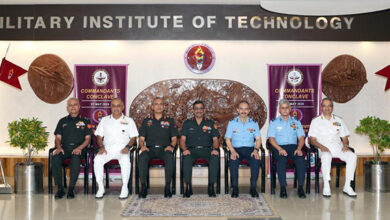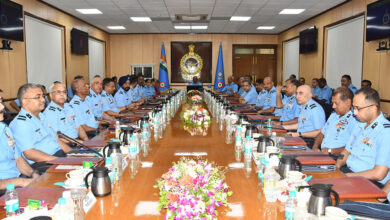IAF expects to induct the new Combat Jets by 2012
New Delhi. India released the much-awaited tender for 126 multi role combat aircraft (MRCA) to six manufacturers August 28, with the Indian Air Force (IAF) Chief of Air Staff saying that “he expected the new jets to be inducted before or by 2012.”
Air Chief Marshal F H Major told India Strategic soon after the tender was selectively released to the six vendors that the IAF will complete the required field and weapons trials in less than two years, and that he expected the Ministry of Defence (MoD) also to take around that much time to process the IAF reports.
“The requirement is imminent, and thanks to the MoD’s new acquisition policy, IAF could actually have the first lot of 18 fly-away aircraft from the selected vendor in four to five years.”
India’s weapon acquisition policy has been painfully slow, particularly from 1990 onwards, and the IAF has literally been roaring for jet-speed at the MoD. Except for the SU 30 MKI aircraft it bought from Russia over the last few years, all of its nearly 750 combat aircraft are 20 years old or more than that.
The new acquisition policy, called the Defence Procurement Policy (DPP) 2006, is a fine piece of document prepared by former Secretary (Finance) in the MoD Vinod Mishra and Joint Secretary S N Mishra. If its letter and spirit are followed, the IAF could indeed have the first lot of MRCAs even within four years.
The new aircraft are estimated to cost around US $ 10 billion, inclusive of their weapons, the initial set of spares, training, Transfer of Technology (ToT), and two years’ warranty.
IAF will keep an option to raise their number to around 200 but according to Air Chief Marshal Major, there was no proposal at the moment to do so. “We could exercise that option later,” he had told India Strategic in an earlier interview.
If exercised, the cost of the MRCA project would touch or exceed $ 15 billion.
The tender has been given for the US Boeing F 18, Lockheed Martin F 16, Swedish Gripen, European Consortium’s Eurofighter, Russian Mig 35 and French Rafale. Their representatives were invited to the Ministry and handed over the tender documents, technically called Request for Proposals (RfP).
MoD spokesman Sitanshu Kar said that the manufacturers are to give their response within six months.
There is a 50 per cent offset clause, under which the winning company will have to invest that much value of the contract in the defence sector in India towards building indigenous capability under Transfer of Technology (ToT).
The order is the world’s biggest yet in this century.
IAF will buy the first lot of 18 aircraft direct from the manufacturer while the remaining 108 aircraft would be gradually assembled and manufactured in India under the ToT agreement.
Representatives of Boeing, Gripen and Lockheed Martin issued statements to say that they would do their best to match and exceed the requirements in the tender, while Boeing’s Vice President for Global Strike Systems Chris Chadwick said that his company would develop an economic and technical partnership with Indian companies as part of the offset requirements.
The offset clause is a recent innovation, initiated by former Defence Secretary Shekhar Dutt while the Transfer of Technology in major deals was mandated by former Prime Minister Rajiv Gandhi in the mid-1980s.
Terms of the RfP are secret but sources said that the new aircraft have to be multi-role, that is capable of action against hostile air, surface and maritime targets. They should also have capability for reconnaissance and electronic intelligence roles as well as for midair refueling.
Sources said that as far as the F 16 is concerned, only comparable models to its Block 60 version with Active Electronically Scanned Array (AESA) radar would be considered. Only the UAE Air Force F 16s, acquired from 2004, have this capability.
For the first time, private sector companies in India will be given a substantial role in defence equipment manufacture.
The RfP gives a free hand to the six manufacturers to choose their partners from among the public or private sector companies.
But the Hindustan Aeronautics Limited (HAL) has been mandated as the lead systems integrator, which will finally assemble the aircraft from imported and Indian-made components.
The $ 2 billion HAL has been producing an assortment of Western and Russian aircraft and missiles.
According to a survey published by the India Strategic, India needs to invest $ 35 to 40 billion by 2025 on military aviation, for the simple reason that it needs to replace/ upgrade nearly its entire combat fleet, except the SU 30 MKIs.
IAF has had a very high incidence of accidents, thanks to the lack of training equipment, trainer jets, and new aircraft to match the demands of modern warfare. The new trainer aircraft, BAE Systems’ Hawks, will be coming over the next few weeks after a 23-year wait.
The reason: the acquisition process over the induction of new systems was crippled in the Ministry of Defence over allegations of bribe in the Bofors gun deal. V P Singh, who succeeded Rajiv Gandhi as the Prime Minister, virtually put a stop to all acquisitions and the process of buying new systems began only after Pakistan occupied parts of Indian terriotory in Kashmir, leading to the 1999 Kargil War.





